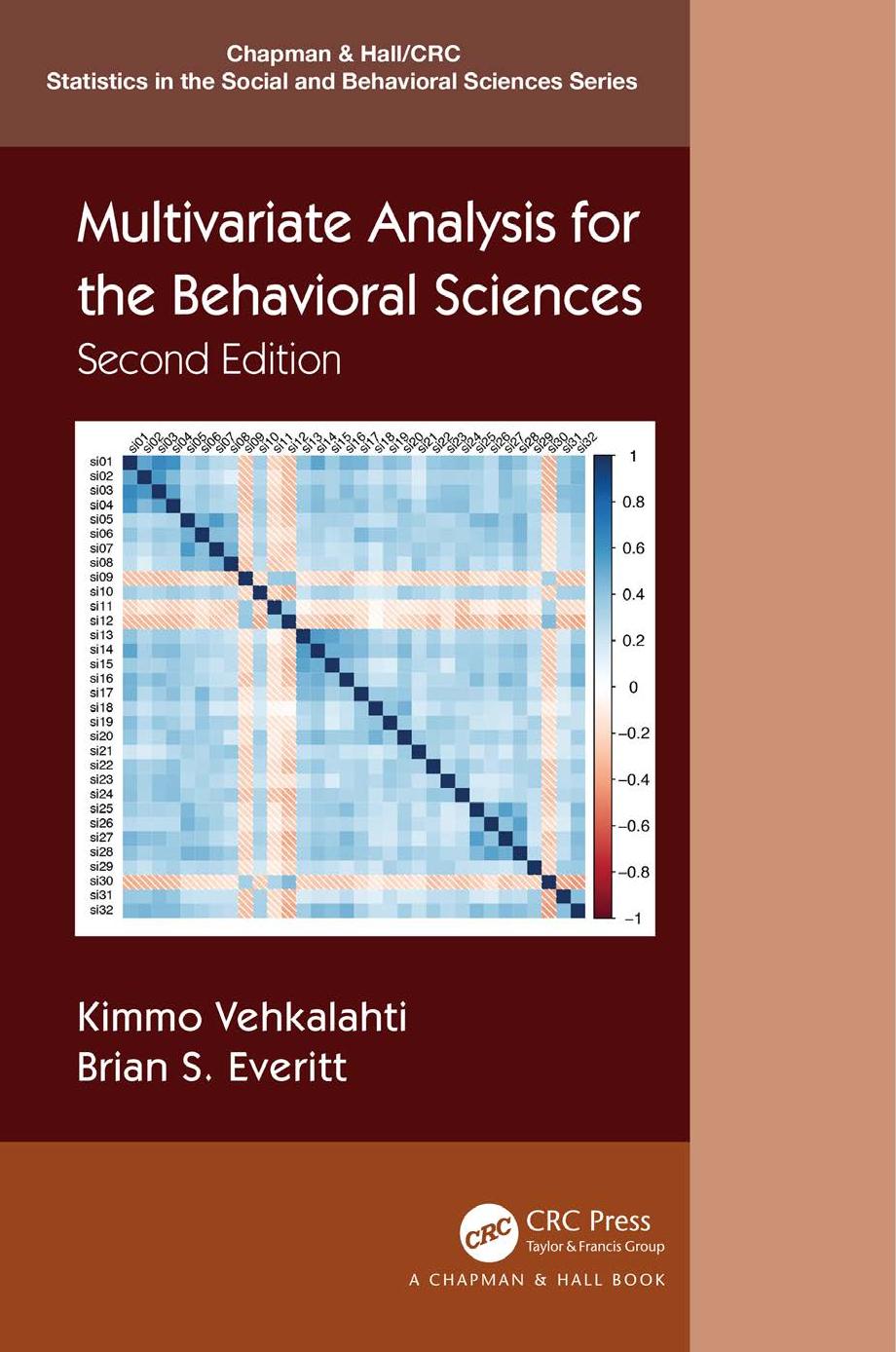Multivariate Analysis for the Behavioral Sciences, Second Edition 2nd Edition by Kimmo Vehkalahti, Brian S Everitt ISBN 1351202251 9781351202251
$70.00 Original price was: $70.00.$35.00Current price is: $35.00.
Instant download Multivariate Analysis for the Behavioral Sciences 2nd after payment
Multivariate Analysis for the Behavioral Sciences, Second Edition 2nd Edition by Kimmo Vehkalahti, Brian S Everitt – Ebook PDF Instant Download/Delivery: 1351202251,
Full dowload Multivariate Analysis for the Behavioral Sciences, Second Edition 2nd Edition after payment
Product details:
Multivariate Analysis for the Behavioral Sciences, Second Edition 2nd Table of contents:
1. Data, Measurement, and Models
1.1 Introduction
1.2 Types of Study
1.2.1 Surveys
1.2.2 Experiments
1.2.3 Observational Studies
1.2.4 Quasi-Experiments
1.3 Types of Measurement
1.3.1 Nominal or Categorical Measurements
1.3.2 Ordinal Scale Measurements
1.3.3 Interval Scales
1.3.4 Ratio Scales
1.3.5 Response and Explanatory Variables
1.4 Missing Values
1.5 The Role of Models in the Analysis of Data
1.6 Determining Sample Size
1.7 Significance Tests, p-Values, and Confidence Intervals
1.8 Summary
1.9 Exercises
2. Looking at Data
2.1 Introduction
2.2 Simple Graphics—Pie Charts, Bar Charts, Histograms, and Boxplots
2.2.1 Categorical Data
2.2.2 Interval/Quasi-Interval Data
2.3 The Scatterplot and beyond
2.3.1 The Bubbleplot
2.3.2 The Bivariate Boxplot
2.4 Scatterplot Matrices
2.5 Conditioning Plots and Trellis Graphics
2.6 Graphical Deception
2.7 Summary
2.8 Exercises
3. Simple Linear and Locally Weighted Regression
3.1 Introduction
3.2 Simple Linear Regression
3.2.1 Fitting the Simple Linear Regression Model to the Pulse Rates and Heights Data
3.2.2 An Example from Kinesiology
3.3 Regression Diagnostics
3.4 Locally Weighted Regression
3.4.1 Scatterplot Smoothers
3.5 Summary
3.6 Exercises
4. Multiple Linear Regression
4.1 Introduction
4.2 An Example of Multiple Linear Regression
4.3 Choosing the Most Parsimonious Model When Applying Multiple Linear Regression
4.3.1 Automatic Model Selection
4.3.2 Example of Application of the Backward Elimination
4.4 Regression Diagnostics
4.5 Multiple Linear Regression and Analysis of Variance
4.5.1 Analyzing the Fecundity of Fruit Flies by Regression
4.5.2 Multiple Linear Regression for Experimental Designs
4.5.3 Analyzing a Balanced Design
4.5.4 Analyzing an Unbalanced Design
4.6 Summary
4.7 Exercises
5. Generalized Linear Models
5.1 Introduction
5.2 Binary Response Variables
5.3 Response Variables That Are Counts
5.3.1 Overdispersion and Quasi-Likelihood
5.4 Summary
5.5 Exercises
6. Applying Logistic Regression
6.1 Introduction
6.2 Odds and Odds Ratios
6.3 Applying Logistic Regression to the GHQ Data
6.4 Selecting the Most Parsimonious Logistic Regression Model
6.5 Driving and Back Pain: A Matched Case–Control Study
6.6 Summary
6.7 Exercises
7. Survival Analysis
7.1 Introduction
7.2 The Survival Function
7.2.1 Age at First Sexual Intercourse for Women
7.3 The Hazard Function
7.4 Cox’s Proportional Hazards Model
7.4.1 Retention of Heroin Addicts in Methadone Treatment
7.5 Summary
7.6 Exercises
8. Analysis of Longitudinal Data I: Graphical Displays and Summary Measure Approach
8.1 Introduction
8.2 Graphical Displays of Longitudinal Data
8.3 Summary Measure Analysis of Longitudinal Data
8.3.1 Choosing Summary Measures
8.3.2 Applying the Summary Measure Approach
8.3.3 Incorporating Pre-Treatment Outcome Values into the Summary Measure Approach
8.3.4 Dealing with Missing Values When Using the Summary Measure Approach
8.4 Summary
8.5 Exercises
9. Analysis of Longitudinal Data II: Linear Mixed EffectsModels for Normal Response Variables
9.1 Introduction
9.2 Linear Mixed Effects Models for Repeated Measures Data
9.3 How Do Rats Grow?
9.3.1 Fitting the Independence Model to the Rat Data
9.3.2 Fitting Linear Mixed Models to the Rat Data
9.4 Computerized Delivery of Cognitive Behavioral Therapy—Beat the Blues
9.5 Summary
9.6 Exercises
10. Analysis of Longitudinal Data III: Non-Normal Responses
10.1 Introduction
10.2 Marginal Models and Conditional Models
10.2.1 Marginal Models
10.2.2 Conditional Models
10.3 Using Generalized Estimating Equations to Fit Marginal Models
10.3.1 Beat the Blues Revisited
10.3.2 Respiratory Illness
10.3.3 Epilepsy
10.4 Using Generalized Linear Mixed Effects Models to Fit Conditional Models
10.4.1 Respiratory Illness
10.4.2 Epilepsy
10.5 Summary
10.6 Exercises
11. Missing Values
11.1 Introduction
11.2 Missing Data Mechanisms
11.3 Dealing with Missing Values
11.4 Imputing Missing Values
11.5 Analyzing Multiply Imputed Data
11.6 Example of the Application of Multiple Imputation
11.6.1 Complete-Case Analysis
11.6.2 Mean Imputation
11.6.3 Multiple Imputation
11.7 Beat the Blues Revisited (Again)
11.8 Summary
11.9 Exercises
12. Multivariate Data and Multivariate Analysis
12.1 Introduction
12.2 The Initial Analysis of Multivariate Data
12.2.1 Summary Statistics for Multivariate Data
12.2.2 Graphical Descriptions of the Body Measurement Data
12.3 The Multivariate Normal Probability Density Function
12.3.1 Assessing Multivariate Data for Normality
12.4 Summary
12.5 Exercises
13. Principal Components Analysis
13.1 Introduction
13.2 Principal Components Analysis (PCA)
13.3 Finding the Sample Principal Components
13.4 Should Principal Components be Extracted fromthe Covariance or the Correlation Matrix?
13.5 Principal Components of Bivariate Data with Correlation Coefficient r
13.6 Rescaling the Principal Components
13.7 How the Principal Components Predict the Observed Covariance Matrix
13.8 Choosing the Number of Components
13.9 Calculating Principal Component Scores
13.10 Some Examples of the Application of PCA
13.10.1 Head Size of Brothers
13.10.2 Crime Rates in the United States
13.10.3 Drug Usage by American College Students
13.11 Using PCA to Select a Subset of the Variables
13.12 Summary
13.13 Exercises
14. Multidimensional Scaling and Correspondence Analysis
14.1 Introduction
14.2 Multidimensional Scaling
14.2.1 Classical Multidimensional Scaling
14.2.2 Connection to Principal Components
14.2.3 Road Distances in Finland
14.2.4 Mapping Composers of Classical Music
14.2.5 Nonmetric Multidimensional Scaling
14.2.6 Re-mapping Composers of Classical Music
14.3 Correspondence Analysis
14.3.1 Simple Example of the Application of Correspondence Analysis
14.3.2 Connections of Work Activities and Job Advantages
14.4 Summary
14.5 Exercises
15. Exploratory Factor Analysis
15.1 Introduction
15.2 The Factor Analysis Model
15.3 Estimating the Parameters in the Factor Analysis Model
15.4 Determining the Number of Factors
15.5 Fitting the Factor Analysis Model: An Example
15.6 Rotation of Factors
15.6.1 A Simple Example of Graphical Rotation
15.6.2 Numerical Rotation Methods
15.6.3 A Simple Example of Numerical Rotation
15.7 Estimating Factor Scores
15.7.1 Analyzing the Crime Rates by Factor Analysis
15.8 Exploratory Factor Analysis and Principal Component Analysis Compared
15.9 Summary
15.10 Exercises
16. Confirmatory Factor Analysis and Structural Equation Models
16.1 Introduction
16.2 Estimation, Identification, and Assessing the Fit for Confirmatory Factor Analysis and Structural Equation Models
16.2.1 Estimation
16.2.2 Identification
16.2.3 Assessing the Fit
16.3 Examples of Confirmatory Factor Analysis
16.3.1 Ability and Aspiration
16.3.2 Drug Usage among Students
16.4 Eight Factors of Systems Intelligence
16.4.1 Testing the Factorial Validity of the SI Inventory
16.5 Structural Equation Models
16.5.1 Example of a Structural Equation Model
16.6 Summary
16.7 Exercises
17. Cluster Analysis
17.1 Introduction
17.2 Cluster Analysis
17.3 Agglomerative Hierarchical Clustering
17.3.1 Clustering Individuals Based on Body Measurements
17.3.2 Clustering Countries on the Basis of Life Expectancy
17.4 k-Means Clustering
17.4.1 Clustering Crime Rates
17.5 Model-Based Clustering
17.5.1 Clustering European Countries
17.6 Summary
17.7 Exercises
18. Grouped Multivariate Data
18.1 Introduction
18.2 Two-Group Multivariate Data
18.2.1 Hotelling’s T2 Test
18.2.2 Fisher’s Linear Discriminant Function
18.3 More Than Two Groups
18.3.1 Multivariate Analysis of Variance (MANOVA)
18.3.2 Classification Functions
18.4 Summary
18.5 Exercises



